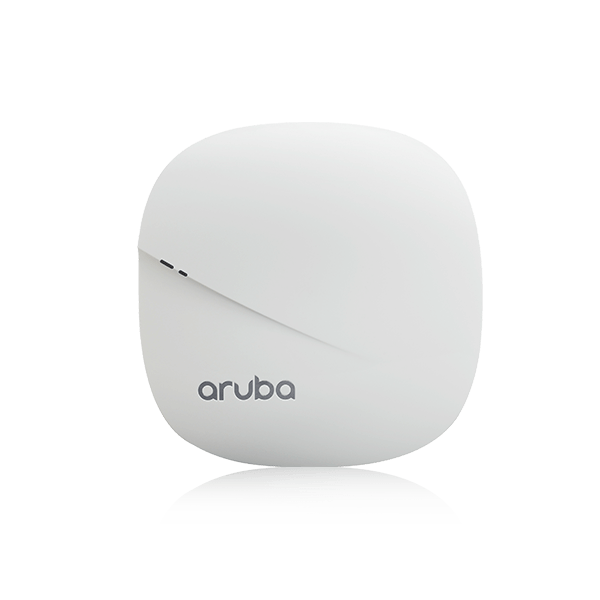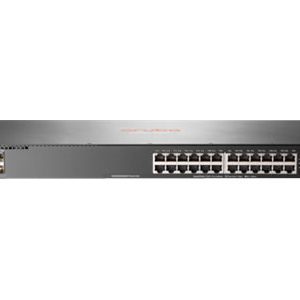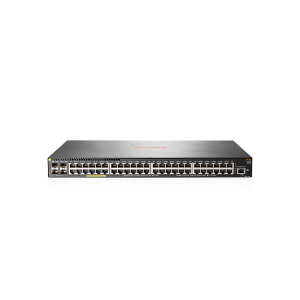KEY FEATURES
• Dual Radio 802.11ac Access Point – Supports up to 867 Mbps in the 5GHz band (with 2SS/VHT80 clients) and up to 400 Mbps in the 2.4GHz band (with 2SS/VHT40 clients).
• Built-in Bluetooth Low-Energy (BLE) radio
– Enables location-based services with BLE-enabled mobile devices receiving signals from multiple Aruba Beacons at the same time.
– Enables management of a network of Aruba Beacons.
• Advanced Cellular Coexistence (ACC) – Minimizes interference from 3G/4G cellular networks, distributed antenna systems and commercial small cell/femtocell equipment.
• Quality of Service for Unified Communication apps – Supports priority handling and policy enforcement for unified communication apps, including Microsoft Skype for Business, with encrypted videoconferencing, voice, chat and desktop sharing.
• RF Management
– Adaptive Radio Management (ARM) technology automatically assigns channel and power settings, provides airtime fairness, and ensures that APs stay clear of all sources of RF interference to deliver reliable, high-performance WLANs.
– The Aruba 207 Series APs can be configured to provide part-time or dedicated air monitoring for wireless intrusion protection, VPN tunnels to extend remote locations to corporate resources, and wireless mesh connections where Ethernet drops are not available.
• Intelligent app visibility and control
– AppRF technology leverages deep packet inspection to classify and block, prioritize, or limit bandwidth for thousands of
applications in a range of categories
• Security
– Integrated wireless intrusion protection offers threat protection and mitigation, and eliminates the need for separate RF
sensors and security appliances.
– IP reputation and security services identify, classify, and block malicious files, URLs and IPs, providing comprehensive
protection against advanced online threats.
– Integrated Trusted Platform Module (TPM) for secure storage of credentials and keys.
AP-207 Series Specifications
AP-207 (controller-managed) and IAP-207 (Instant):
– 802.11ac – 5GHz 2×2 MIMO (867 Mbps max rate) and 2.4GHz 2×2 MIMO (400 Mbps
max rate) radios, with a total of two integrated omni-directional downtilt dualband
antennas
Wi-Fi Radio Specifications
• AP type: Indoor, dual radio, 5GHz 802.11ac 2×2 MIMO and 2.4GHz 802.11n 2×2 MIMO
• Software-configurable dual radio supports 5GHz (Radio 0) and 2.4GHz (Radio 1)
• 5GHz: Two spatial stream Single User (SU) MIMO for up to 867 Mbps wireless data
rate to individual 2×2 VHT80 client devices
• 2.4GHz: Two spatial stream Single User (SU) MIMO for up to 400 Mbps wireless data
rate to individual 2×2 VHT40 client devices (300 Mbps for HT40 802.11n client devices)
• Support for up to 256 associated client devices per radio, and up to 16 BSSIDs per
radio
• Supported frequency bands (country-specific restrictions apply):
– 2.400 to 2.4835GHz
– 5.150 to 5.250GHz
– 5.250 to 5.350GHz
– 5.470 to 5.725GHz
– 5.725 to 5.850GHz
• Available channels: Dependent on configured regulatory domain
• Dynamic frequency selection (DFS) optimizes the use of available RF spectrum
• Supported radio technologies:
– 802.11b: Direct-sequence spread-spectrum (DSSS)
– 802.11a/g/n/ac: Orthogonal frequency-division multiplexing (OFDM)
• Supported modulation types:
– 802.11b: BPSK, QPSK, CCK
– 802.11a/g/n/ac: BPSK, QPSK, 16-QAM, 64-QAM, 256-QAM
• Transmit power: Configurable in increments of 0.5 dBm
• Maximum (conducted) transmit power (limited by local regulatory requirements):
– 2.4GHz band: +18 dBm per chain, +21 dBm aggregate (2×2)
– 5GHz band: +18 dBm per chain, +21 dBm aggregate (2×2)
– Note: conducted transmit power levels exclude antenna gain. For total (EIRP) transmit
power, add antenna gain
• Advanced Cellular Coexistence (ACC) minimizes interference from cellular networks
• Maximum ratio combining (MRC) for improved receiver performance
• Cyclic delay/shift diversity (CDD/CSD) for improved downlink RF performance
• Short guard interval for 20MHz, 40MHz and 80MHz channels
• Space-time block coding (STBC) for increased range and improved reception
• Low-density parity check (LDPC) for high-efficiency error correction and increased
throughput
Wi-Fi Antennas
• AP-207/IAP-207: Two integrated dual-band downtilt omni-directional antennas for
2×2 MIMO with peak antenna gain of 3.4dBi in 2.4GHz and 6.6dBi in 5GHz. Built-in
antennas are optimized for horizontal ceiling mounted orientation of the AP. The
downtilt angle for maximum gain is roughly 30 degrees.
– Combining the patterns of each of the antennas of the MIMO radios, the peak gain of
the effective per-antenna pattern is 2.2dBi in 2.4GHz and 4.5dBi in 5GHz.
Other Interfaces
• One 10/100/1000BASE-T Ethernet network interface (RJ-45)
– Auto-sensing link speed and MDI/MDX
– 802.3az Energy Efficient Ethernet (EEE)
• Bluetooth Low Energy (BLE) radio
– Up to 3dBm transmit power (class 2) and -92dBm receive sensitivity
– Integrated antenna with roughly 30 degrees downtilt and peak gain of 2.2dBi
• Visual indicators (multi-color LEDs): for System and Radio status
• Reset button: factory reset (during device power up)
• Serial console interface (proprietary; optional adapter cable available)
• Kensington security slot
Power Sources and Consumption
• The AP supports direct DC power and Power over Ethernet (PoE)
• When both power sources are available, DC power takes priority over PoE
• Power sources are sold separately
• Direct DC source: 12Vdc nominal, +/- 5% – Interface accepts 2.1/5.5-mm centerpositive circular plug with 9.5-mm length
• Power over Ethernet (PoE): 48 Vdc (nominal) 802.3af/802.3at compliant source –
Unrestricted functionality with 802.3af PoE
• Maximum (worst-case) power consumption: 12.3W (PoE) or 10.1W (DC)
• Maximum (worst-case) power consumption in idle mode: 5.3W (PoE) or 4.4W (DC)
Mounting
• The AP ships with two (black) mounting clips to attach to a 9/16-inch or 15/16-inch







Reviews
There are no reviews yet.